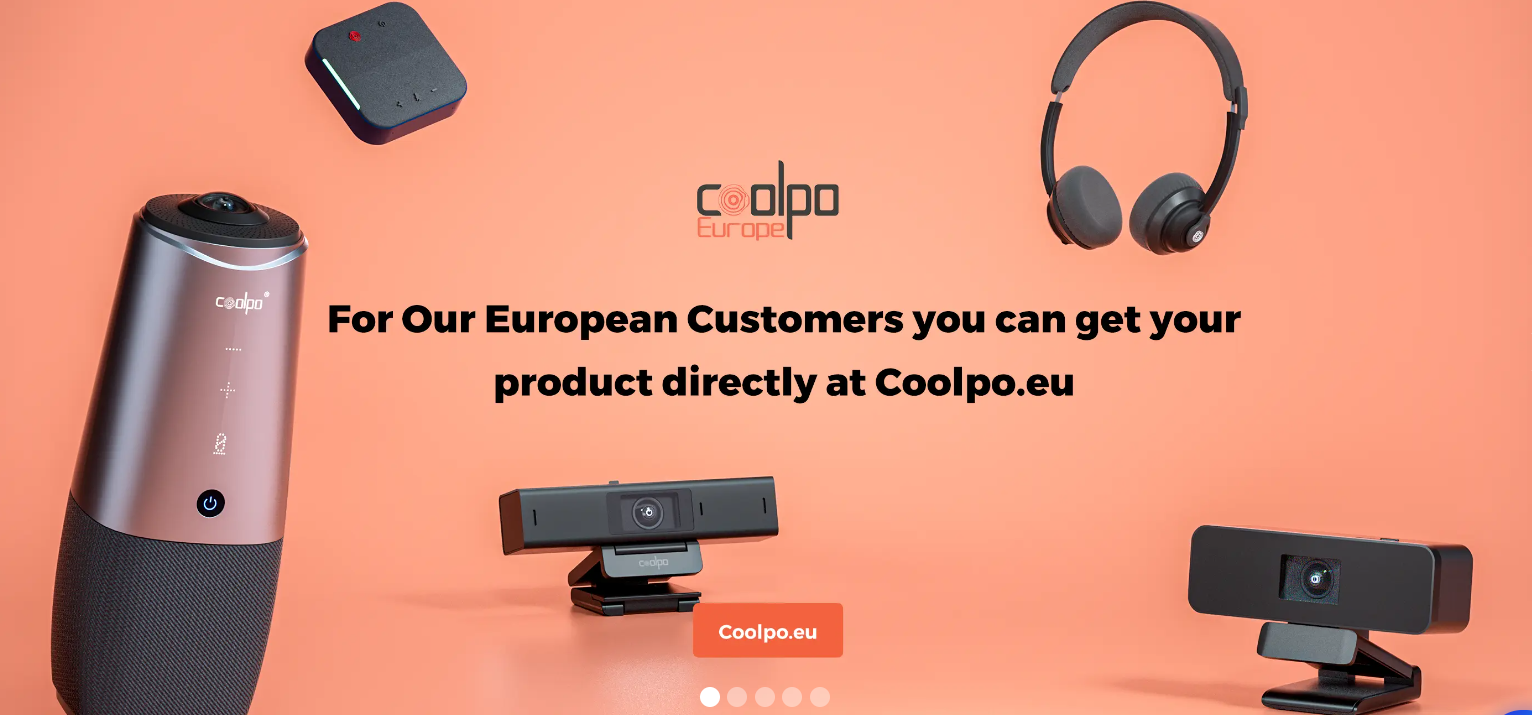Top Trends in AI-powered Video Conference Devices for 2025

AI is revolutionizing how you connect and collaborate in hybrid work environments. AI-powered video conference devices are no longer optional—they are essential. These tools enhance productivity and meeting quality, with 98% of users reporting improved efficiency. By 2025, groundbreaking advancements like real-time transcription, virtual avatars, and dynamic participant framing will redefine your meeting experience. The market for these devices is growing rapidly, with a projected annual growth rate of 16.8%. All-in-one AI-powered video conference devices will play a pivotal role in shaping the future of communication.
Key Takeaways
AI video tools help improve work and meeting quality in hybrid jobs.
Live transcription and translation remove language problems, helping global teams connect.
Gesture recognition lets users interact easily, making meetings more exciting.
Automatic meeting notes save time and keep everyone on the same page.
360° cameras make meetings feel real, like everyone is in the room.
Emerging Trends in AI-powered Video Conference Devices
Advanced AI Features
Real-time transcription and translation
AI-powered tools are revolutionizing video conferencing by offering real-time transcription and translation. These features enhance accessibility and comprehension for participants from diverse linguistic backgrounds. Natural Language Processing (NLP) ensures accurate transcription, making it easier for you to follow discussions. AI-powered transcription also supports inclusivity, enabling seamless communication in hybrid meetings. This technology is particularly beneficial for global teams, as it breaks down language barriers and fosters better collaboration.
Gesture recognition for seamless interaction
Gesture recognition is transforming how you interact during virtual meetings. AI can now detect hand gestures and facial expressions, allowing you to control presentations or signal actions without interrupting the flow of the meeting. This feature enhances engagement and creates a more interactive experience. For example, you can raise your hand virtually or use simple gestures to navigate slides, making meetings more dynamic and efficient.
Automated meeting summaries and action items
AI-powered tools now generate automated meeting summaries and action items, saving you time and effort. Generative AI and natural language modeling have made these summaries more precise and actionable. Late participants can catch up quickly with mini summaries, while real-time action item creation ensures that tasks are clearly defined. This innovation boosts productivity and keeps everyone aligned, even in fast-paced video conferencing environments.
Hardware Innovations
360° cameras for immersive experiences
360° videoconferencing cameras are redefining how you experience hybrid meetings. These cameras provide a panoramic view of the room, capturing all participants and creating an immersive environment. Remote attendees can enjoy a more immersive meeting using digital pan, tilt, and zoom, making them feel as if they are physically present. This technology enhances engagement and fosters natural collaboration, bridging the gap between in-person and remote participants.
Low-latency processors for smoother communication
Low-latency processors are critical for ensuring smooth communication during video conferencing. These processors minimize delays, allowing for real-time interaction without interruptions. Whether you're in a high-stakes business meeting or a casual virtual gathering, low-latency technology ensures that your conversations flow naturally, enhancing the overall experience.
Compact, portable designs for on-the-go professionals
Modern video conferencing devices are becoming more compact and portable, catering to the needs of on-the-go professionals. These designs make it easier for you to set up meetings anywhere, whether you're working from a coffee shop or traveling for business. Portable devices ensure that you stay connected and productive, no matter where you are.
Integration with Hybrid Work Models
AI tools tailored for remote and in-office collaboration
AI-powered tools are bridging the gap between remote and in-office collaboration. Features like intelligent noise cancellation and auto-framing ensure that all participants are equally represented, regardless of their location. These tools create a level playing field, making hybrid meetings more inclusive and effective.
Enhanced virtual presence for distributed teams
AI is enhancing virtual presence by making remote participants feel more connected. Dynamic background changes and emotive AI features improve comfort and satisfaction during video conferencing. These advancements ensure that distributed teams can collaborate effectively, even when they are miles apart.
Scalability for businesses of all sizes
AI-powered video conference devices are designed to scale with your business needs. Whether you're a small startup or a large enterprise, these devices can handle increasing workloads and adapt to your growing requirements. Geographic scalability allows you to access AI systems from anywhere, making them ideal for global teams and remote collaboration.
Key Features to Watch in 2025
Facial Recognition and Personalization
Customized user profiles for tailored experiences
AI-powered video conferencing devices are transforming how you interact during virtual meetings. Facial recognition technology now enables customized user profiles, offering tailored experiences for every participant. These profiles adapt to your preferences, such as camera angles, lighting, or even preferred virtual backgrounds. AI-driven facial recognition can also detect subtle facial expressions, providing insights into participants' emotional states. This allows facilitators to adjust their communication styles, ensuring higher engagement levels.
Tip: Personalized profiles not only enhance your experience but also make virtual meetings more inclusive and efficient.
Here’s a breakdown of how facial recognition works in video conferencing:
Feature | Description |
|---|---|
Face detection | Identifies and isolates a face from an image or video feed using computer vision techniques. |
Feature extraction | Extracts unique facial features that form the basis for the individual’s identity. |
Facial encoding | Converts extracted features into a unique numerical faceprint for future recognition. |
Authentication | Compares captured face to a stored reference for identity verification. |
Emotion analysis | Detects emotional states and engagement levels through facial expressions during video calls. |
Enhanced security through biometric authentication
Biometric authentication is raising the bar for security in video conferencing platforms. AI-powered tools now use facial recognition to verify identities, ensuring that only authorized participants can join your meetings. This feature protects sensitive information and prevents unauthorized access. With AI, you can enjoy a secure and seamless conferencing experience.
Noise Suppression and Audio Enhancements
AI-driven background noise elimination
AI is revolutionizing audio quality in video conferencing. AI-powered tools now eliminate background noise in real time, ensuring clear communication. Whether you’re in a bustling café or a noisy home office, this feature filters out distractions, allowing you to focus on the conversation.
Adaptive audio optimization for different environments
AI adapts audio settings based on your environment. It optimizes sound quality for both quiet and noisy spaces, ensuring that every word is heard clearly. The rise of spatial audio technology creates an immersive sound experience, making virtual meetings feel more natural. These advancements improve communication quality and enhance collaboration in hybrid work environments.
Whiteboard Extraction and Collaboration Tools
Real-time digitization of physical whiteboards
AI-powered video conferencing devices now offer real-time digitization of physical whiteboards. This feature captures and converts handwritten notes into digital formats, making them accessible to all participants. You can share ideas seamlessly, even if some team members are remote.
AI-powered brainstorming and idea organization
AI tools are taking collaboration to the next level. They assist in brainstorming sessions by organizing ideas and generating actionable insights. Automated note-taking and meeting analytics ensure that no detail is missed. These tools foster creativity and streamline your workflow, making every meeting more productive.
Top Devices and Tools for AI-powered Video Conferencing

Leading Devices in the Market
Coolpo AI Huddle PANA: 360° all-in-one AI-powered video conference device
The Coolpo AI Huddle PANA stands out as a cutting-edge ai-powered video conference device. Its 360° panoramic HD camera ensures everyone in the room is visible, creating immersive hybrid meeting experiences. The device features smart tracking and framing, automatically focusing on active speakers to enhance engagement. With its plug-and-play setup and compatibility with major operating systems like Windows and Mac OS, the PANA simplifies video conferencing for small collaborative spaces. Its 4 smart microphones and 360° speaker deliver crystal-clear audio, making it ideal for both remote and in-person collaboration.
Feature | Details |
|---|---|
Video | 360-degree camera, Panoramic HD resolution |
Audio | 8 smart microphones, 360-degree speaker |
Connectivity | USB plug and play, power cable |
Supported OS | Windows 10&11, Mac OS |
Best for | Small collaborative spaces (up to 15 people) |
Setup | USB driver-free installation, plug-and-play |
Participation | Smart 360° camera with automatic tracking |
Owl Labs Meeting Owl 3: Intelligent 360° conference camera with extended audio range
The Owl Labs Meeting Owl 3 redefines 360° videoconferencing with its intelligent AI-powered tools. It offers a 360° camera and extended audio range, ensuring every participant is seen and heard. Its AI smart tracking adjusts focus dynamically, keeping the conversation natural and engaging. The device’s wide-angle view and noise cancellation features make it a top choice for hybrid work environments.
NexiGo Meeting 360 (Gen 2): 8K conference camera with AI-powered framing
The NexiGo Meeting 360 (Gen 2) combines 8K video resolution with AI-powered framing to deliver exceptional video quality. Its advanced AI ensures that all participants remain in focus, regardless of their position. This device is perfect for businesses seeking high-quality video conferencing tools for large meetings.
Software Tools Enhancing AI Video Conferencing
Dialpad Ai Meetings: HD video conferencing with built-in AI capabilities
Dialpad Ai Meetings offers a comprehensive suite of features to enhance your video conferencing experience. Its AI-powered productivity tools include live transcription, call summaries, and meeting analytics. The platform supports HD video, crisp audio, and seamless collaboration through screen sharing and whiteboarding.
Feature | Description |
|---|---|
Live transcription, call summaries, and meeting analytics. | |
Global scale | |
Always-on video | Picture-in-picture mode for multitasking during meetings. |
Crisp, clear audio | Real-time noise cancellation for distraction-free communication. |
Unlimited collaboration | Screen sharing, whiteboarding, and file sharing. |
Pexip Adaptive Composition: AI-driven participant framing for engaging collaboration
Pexip Adaptive Composition uses AI to frame participants dynamically, ensuring everyone is equally represented. This feature enhances engagement and creates a more inclusive environment for hybrid meetings. Its seamless integration with existing video conferencing platforms makes it a valuable tool for businesses.
Integration with Ecosystems
Compatibility with productivity platforms like Microsoft Teams and Zoom
AI-powered video conference devices now integrate effortlessly with popular productivity platforms like Microsoft Teams and Zoom. These integrations streamline business communication by enabling features like real-time transcription, dynamic participant framing, and AI-generated summaries. You can enjoy a seamless workflow without switching between tools.
Seamless integration with smart office setups
AI-powered tools enhance smart office setups by automating tasks and optimizing bandwidth usage. Features like virtual backgrounds and real-time transcription improve the overall meeting experience. AI-driven meeting rooms ensure equitable participation for both in-person and remote attendees, fostering better collaboration in modern workplaces.
Future Implications of AI-powered Video Conferencing
Transforming the Future of Work
Enhanced productivity and collaboration
AI-powered video conferencing is reshaping how you work by boosting productivity and fostering collaboration. Real-time transcription ensures accessibility for participants with hearing impairments, creating an inclusive environment. AI-driven algorithms enhance audio and video quality, ensuring clear communication during meetings. Intelligent meeting assistants automate tasks like scheduling and note-taking, saving time and allowing you to focus on meaningful discussions. With 98% of participants and 94% of businesses reporting increased productivity, AI-powered tools are becoming indispensable for modern workplaces.
Bridging the gap between remote and in-office teams
AI-powered tools are bridging the divide between remote and in-office teams. Features like automated meeting summaries and real-time language translation ensure that everyone stays aligned, regardless of location. Hybrid meetings benefit from AI’s ability to create a level playing field, making remote collaboration seamless. These advancements foster stronger connections and improve teamwork, even in distributed settings.
Shaping Communication and Connectivity
More natural and intuitive interactions
AI is making video conferencing more intuitive. Gesture recognition allows you to interact naturally by controlling presentations or signaling actions with hand movements. AI-powered facial recognition and emotion analysis provide insights into participants’ engagement levels, helping facilitators adjust their approach. Virtual backgrounds and augmented reality features create immersive environments, enhancing the overall meeting experience.
Breaking language and cultural barriers
AI-powered transcription and translation services are breaking down language barriers in video conferencing. These tools provide real-time text and translations, enabling seamless communication among participants speaking different languages. Closed captioning ensures that everyone can follow along, fostering inclusivity in multicultural settings. By minimizing misunderstandings, these features make meetings more productive and meaningful.
Ethical and Privacy Considerations
Balancing innovation with user privacy
AI-enabled video conferencing platforms collect and analyze large amounts of data, raising privacy concerns. Protecting user data through encryption and robust authentication mechanisms is essential. Clear privacy policies and consent mechanisms help build trust and ensure transparency. Self-hosting AI solutions can also give organizations greater control over their data, addressing privacy and security requirements.
Addressing concerns around data security
Data security remains a critical challenge in AI-powered video conferencing. Strong encryption techniques protect data in transit and at rest, while multi-factor authentication prevents unauthorized access. Real-time monitoring and intrusion detection systems mitigate cyber threats. Ethical considerations, such as addressing biases in AI algorithms, ensure inclusivity and fairness in video conferencing platforms. These measures safeguard your data while fostering trust in AI-driven solutions.
AI-powered video conference devices are reshaping how you connect and collaborate. By 2025, advanced features like multilingual translations, emotion detection, and real-time meeting assistants will enhance productivity and meeting quality. Businesses adopting these technologies can expect significant benefits, as 94% of companies report improved efficiency with autonomous AI tools. These devices also integrate seamlessly into hybrid work models, ensuring inclusivity and scalability. Staying informed about these innovations will help you thrive in the evolving workplace and make the most of cutting-edge video conferencing solutions.
FAQ
What is an AI-powered video conference device?
An AI-powered video conference device uses artificial intelligence to enhance virtual meetings. It automates tasks like transcription, noise suppression, and participant framing. These devices improve communication and collaboration by making meetings more efficient and inclusive.
How do AI tools improve hybrid meetings?
AI tools bridge the gap between remote and in-office participants. Features like real-time transcription, gesture recognition, and automated summaries ensure everyone stays engaged and aligned. These tools create a seamless experience for hybrid teams.
Are AI-powered devices secure for business use?
Yes, most AI-powered devices prioritize security. They use encryption, biometric authentication, and other measures to protect sensitive data. Always choose devices from trusted brands to ensure robust security features.
Can AI-powered devices work with existing platforms?
Yes, many AI-powered devices integrate with popular platforms like Microsoft Teams and Zoom. This compatibility allows you to use advanced AI features without changing your current workflow.
What are the benefits of 360° cameras in video conferencing?
360° cameras provide a panoramic view of the meeting room. They ensure all participants are visible, creating an immersive experience. These cameras enhance engagement and make hybrid meetings feel more natural.
See Also
Revolutionizing Appointment Scheduling With Ai For Businesses
Top WhatsApp Bots To Enhance Communication In 2024
How Ai Virtual Receptionists Transform Daily Work Activities
Leading Intercom Solutions For Businesses In The Coming Year
Advancements In PDF Chatbots: Automation And Seamless Integration

